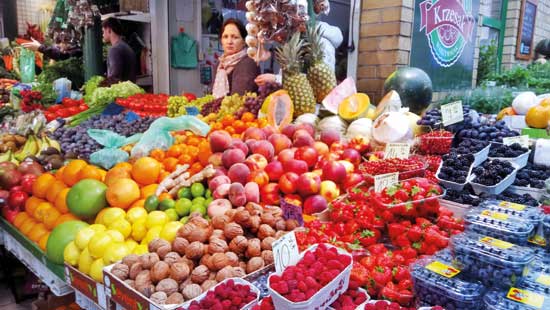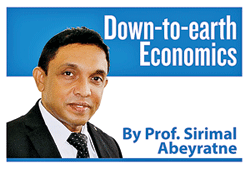“Rules of the game”
View(s):After reading the news, I thought of shedding some light on the subject area of “institutions” which is not a familiar term for us here in
Sri Lanka. We all know “institutions” in our general usage. But it does not mean that they are the “institutions in economics” and, hence “Institutional Economics”.
Let me first place the issue of achieving “prosperity of a nation” in context. Then we would be able to rule out all random factors of prosperity; and get the most common core factors extracted at the end. We may find the term “institutions” there and the relevance of institutions for the prosperity of any nation.

A vegetable market in Poland which thrives on a combination of agriculture and other exports.
What makes a country rich or poor? There are 38 countries in the club of rich countries – the Organisation for Economic Cooperation and Development (OECD). There are about 30 low-income countries and about 50 lower middle-income countries in the world. Since 2001, the number of low-income countries has more than halved, to 31 in 2020 from 64 in 2001.
However, still about 10 per cent of people in the world live in “extreme poverty” while most of them are in the countries belonging to Sub Saharan Africa, South Asia and Latin America. Extreme poverty refers to severe deprivation of people by basic human needs, including food, safe drinking water, sanitation facilities, health, shelter, education and information.
Natural resources
Some nations in the world are rich and prosperous; people there enjoy prosperity. Some other countries in the world remain poor and hence it’s people in those countries who continue to suffer.
Is the difference due to the abundant natural resources that some countries are blessed with – oil, gas, coal, steel, diamond, gold and other minerals? It is true that some countries in West Asia, Africa, Latin America do find their fortune here and earn incomes by extracting and selling such natural resources.
However, what is puzzling is that many of them are not prosperous. Those which achieved prosperity have done so doing things other than extracting natural resources.
By the way, there are many rich countries which have been using others’ resources to become rich – Japan, Singapore, South Korea are some examples from the region. They don’t have natural resources of their own, but scarcity of resources has not been a constraint for their prosperity.
Arable land
What about fertile arable land as a natural resource? Evidence suggests that it is not a necessary condition for achieving prosperity. Apparently, some of the large countries such as the US, Australia, Canada and many European countries do engage in large-scale agriculture production and even export their produce to the rest of the world.
But, surprisingly, agriculture contribution to their prosperity is marginal. The agriculture sector contributes only about 1 per cent of their GDP, whereas only about 2-3 per cent of their work force is occupied in the agriculture sector.
Moreover, smaller countries such as the Netherlands and Israel are the world’s top-ranked agricultural exporters competing well with large countries. The Netherlands, which is smaller than Sri Lanka, is the third largest agricultural exporter in the world after the US and Brazil. Israel is a world leader in agriculture technology and productivity which has enabled the nation to overcome its dry and barren land.
Productive capacity
Production theories suggest that labour, capital and technology are the three most important resources that constitute a country’s productive capacity. And the productive capacity determines the nation’s economic prosperity through higher output, income generation and employment creation.
 Rich countries have a higher productive capacity to produce more in a better way utilising less time and resources and achieve prosperity. Poor countries have a weaker productive capacity and so they produce a little resulting in poor incomes and limited job opportunities.
Rich countries have a higher productive capacity to produce more in a better way utilising less time and resources and achieve prosperity. Poor countries have a weaker productive capacity and so they produce a little resulting in poor incomes and limited job opportunities.
More importantly, we should remember that the countries are not born with a greater productive capacity. They have developed their productive capacity with their own effort in history over a long period of time (like in the UK) or acquired its ingredients from other countries in the world (as Japan and other Asian countries did).
Skilled labour for development can be developed through education and training. But many countries in modern history have resolved their human resource shortages by importing “foreign talent” from other countries. It is any way a “smart move” to import skilled labour from other countries, because they have spent to build them.
No binding constraint
Similarly, capital for investment can also be accumulated by a country’s own effort (through domestic savings) or can be acquired from the rest of the world. There is no shortage of accumulated capital in the world, although it is a scarce resource in developing countries.
During the past 25 years, on average about US$1.5 trillion worth annual capital flows have been seen in the world. However, the irony is that not every country is fortunate enough to attract a sizable fraction of such capital flows in terms of foreign direct investment (FDI). Some countries not only attract large FDI flows, but also retain generated capital for reinvestment.
Technology is a “stock of knowledge” of a nation about converting inputs into output – that is production. For any kind of modern production process of a tangible good or an intangible service, there is no shortage of technology in the world too. It is a commodity for sale or embodied in the package of FDI flows so that it cannot be an obstacle to prosperity in any country.
The expansion of the productive capacity with human resources, capital and technology is not impossible for a country. This means that they are not absolute binding constraints to prevent the achievement of prosperity because any country can have them, if wanted.
Two-fold answer
If we can rule out all above possibilities, the important question is what makes the difference, then? Why do some countries succeed in achieving prosperity, while others don’t?
The answer is two-fold: The difference is due to “policies and institutions”, while the two are not mutually exclusive either – you must have both! Policies are the government decisions and actions supporting the achievement of prosperity and eliminating any obstacles against it.
However, policies alone do not work without the right kind of institutions – established laws, regulations, norms, values, beliefs and attitudes as well as the organisations that exist in the society. All these conditions shape the behaviour patterns of people and performance of the economy. Accordingly, in economics, “institutions are the rules of the game” that everyone sticks to play.
Politicians, bureaucrats, businessmen, trade unions, student organisations, civil society groups, opinion makers – everyone plays according to the “rules of the game” irrespective of whether the game is to support or disrupt the achievement of prosperity.
Institutions are two-types: formal and informal. Formal institutions include laws, regulations and government organisations. Informal institutions have evolved in the society shaping values, attitudes and beliefs as well as informal organisations.
Institutional impasse
Institutions also affect the achievement of prosperity either positively or negatively. Some countries have adopted strict laws and regulations to shape the institutions in order to support prosperity; they are strong states such as those in East and Southeast Asia.
In some other countries, prosperity is undermined by the institutions that affect it negatively. Strong and positive institutions perform a major role in any country, aspiring to become rich, while others struggle to break the negative institutional impasse.
South Korea and North Korea represent the same people, same culture, same history, same language and same soil. But none of them matters as far as the differences in prosperity between the two countries are concerned. What matters are the policies and institutions established and nurtured by two different political systems.
Germany before re-unification in 1990 was also the same nation fallen apart into two countries and remained separated by a man-made wall – the Berlin Wall. People in West Germany became rich and enjoyed prosperity, while people in East Germany were poor and suffered from widespread shortages. The difference in prosperity was due to policies and institutions established by two different political systems.
(The writer is Emeritus Professor of Economics at the University of Colombo and can be reached at sirimal@econ.cmb.ac.lk and follow on Twitter @SirimalAshoka).
Hitad.lk has you covered with quality used or brand new cars for sale that are budget friendly yet reliable! Now is the time to sell your old ride for something more attractive to today's modern automotive market demands. Browse through our selection of affordable options now on Hitad.lk before deciding on what will work best for you!


